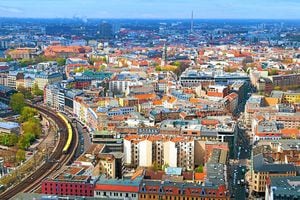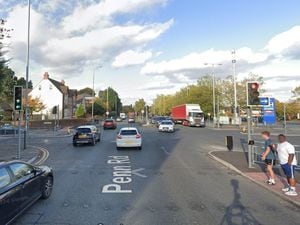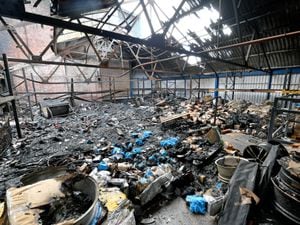Holiday review: Berlin
[gallery] Locals call Berlin 'The Big Village'. With 3.5 million people living within the sprawling city confines, this is easily Germany's biggest in population terms but everyone knows each other.

Well, that's what our laconic guide Markus told us as we started a two-hour tour of the capital of Western Europe's economic powerhouse. Markus has lived here for 20 years and made it sound like 200, but despite his low-key, understated tones, he set the scene of a city finally at peace with itself after a turbulent time at the hands of well, some real despots to be quite frank.
And the city does not attempt to gloss over its inglorious past, neither does it celebrate its part in European history but presents the facts for the visitor to absorb at leisure. And leisure there is aplenty, whatever time of year you choose to pay it a visit.
When I visited, the snow was falling gently onto already slushy roads as we left the gigantic Estrel Hotel in the Tempelhofer-Schonenberg district for a comfortable drive through the contrasting suburbs of a once-divided city.
It is less than 20 years ago that Berlin had The Wall and there is still a sense that you are living in history as you visit the Brandenburg Tor (the German name for gate) and Checkpoint Charlie.
This was my second visit to Berlin and there was no sense of déjà-vu as I had another photograph taken in the shadow of the world-famous towered tor, a glowering symbol of unity.
Such is the popularity of Berlin – 11 million visitors a year making this Europe's third most popular city after London and Paris – you have to jostle for space to get that picture.
But it is worth the effort, even in the cold which grips the populous in winter as the weather sweeps in from the bleakness that often transcends Eastern Europe.
I took refuge in a pavement cafe – the tables were heaped with fluffy snow but inside was warm as the log fire crackled – drank hot chocolate and ate an unhealthy portion of stollen (goodness gracious German food is heavy!) and basked in the hospitality of city at ease with itself and its identity.
It wasn't always the case, of course. Not when The Wall was up in the aftermath of the Second Great War and the now-famous Berlin airlift made Tempelhof arguably the most well-known airport in the world.
The airport is redundant now, a vast, brooding open space awaiting imagination and investment. The city is served by two airports, Tegel and Schonefeld, neither of which is fit for purpose in this modern age but the new one at Brandenburg which was due to open in June last year is way behind schedule and no one, really, has a clue when it will open.
Which is most unlike the Germans, renowned for their Teutonic efficiency, but don't be put off visiting this amazing city. For there is simply so much to see and do – from a myriad of museums to the zoological gardens, the remains of The Wall and the balanced entertainment offer. And you can see the city by bike, by boat or by bus.
And in wintertime, there are the Christmas markets. There are – and these are officials figures – more than 60, so goodness knows how many stalls are dotted around the squares and outside of the many places of interest.
There is a particularly impressive offer in the shadow of the French Cathedral, a small tented city specialising in handicrafts, mouth-blown glassware and replicas of historical steam engines.
Visitors to the Rotes Rathaus (Red Town hall) can experience the truly traditional German Christmas market complete with its puppeteers, storytellers, children¹s carousels. And you can drink steaming mead – a change from the gluwhein – at a tavern next door.
And then there is Holy S*** Shopping (I kid you not, only the Germans could get away with it) where 150 (only the Germans could be so precise) young designers gather to present their latest fashion, matching jewellery and fancy artistic works.This is shopping accompanied by heavy beats from an open air disco. If you tire of traipsing around and sampling hot, liqueur-laced gluwein – I cheerily suggest a shot of amaretto. I would heartily recommend visiting The Story of Berlin, a tour of the city recreated in the basement of a shopping mall and taking in the last of the once-26 nuclear shelters built in and around Berlin during the Cold War.
The bunker was decidedly eerie. . . each of the 26 could hold only 3,200 people, no baggage or anything remotely essential – and it was strictly first-come, first-in.
Once the bunker was full that was it. The double doors in the airlocks slammed shut and those left outside had to take their chances with the nuclear fallout. Thankfully it never happened, but it was nonetheless chilling to be inside, as I stated earlier, living history.
There was food and drink for two weeks and, after that, it was back to the grim wastelands of the outside world. Film buffs can think of I Am Legend, Will Smith's remake of Charlton Heston's Omega Man, or Denzel Washington's Book of Eli to conjure a picture of what life would have been like in a post-nuclear landscape.
The interactive museum showcases more than 800 years of Berlin history and there are relics of the old Wall – some of the rare limited sections, only six of which remain in Germany – alongside a Trabant car and some quite compelling artefacts.
This is indeed a city of quite magnificent contrasts. Thanks to Lufthansa we had a seamless flight and our hosts at the Estrel Hotel – Europe's biggest with 1,125 bedrooms, five restaurants, two bars, fitness centre, garden and, oh yes, the ginormous 30,000 sq ft glass covered atrium – were welcoming.
My hotel room was bigger than my flat at home. Two trapeze artists performed in the foyer on our first night at the Estrel. This is a BIG place.
But what a place. . . if you get a chance to visit, it is well worth the effort.
I travelled courtesy of Lufthansa who were excellent hosts, as were the management of the amazing Estrel, which describes itself as a venue and it is an apt description with its variety of eateries and bars, entertainment and conference space.
Facts:
Birmingham to Berlin is a once daily service (each way) with fares from £39 one way and return from £79.
As with all Lufthansa fares these prices include all taxes and charges, hold baggage allowance (currently 23kg), cabin baggage allowance, in-flight food and drink, the ability to check-in on line, or at the airport for one all-inclusive fare.
There is also the opportunity for passengers to collect miles with Europe's largest airline loyalty programme, Miles & More.
Berlin by Martyn Torr





